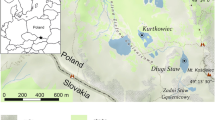Abstract
The “greatest lake period” means that the lakes are in the stage of their maximum areas. As the paleo lake shorelines are widely distributed in the lake basins on the Tibetan Plateau, the lake areas during the “greatest lake period” may be inferred by the last highest lake shorelines. They are several, even tens times larger than that at present. According to the analyses of tens of lakes on the Plateau, most dating data fell into the range of 40-25 ka BP, some lasted to 20 ka BP. It was corresponded to the stage 3 of marine isotope and interstitial of last glaciation. The occurrence of maximum areas of lakes marked the very humid period on the Plateau and was also related to the stronger summer monsoon during that period.
Similar content being viewed by others
References
Yang Yichou, Li Bingyuan, Yin Zeshenget al. Geomorphology of Xizang (Tibet). Beijing: Science Press, 1983. 166–199.
Zheng Mianping, Liu Wengao, Xiang Junet al. On salt lake in Tibet, China.Acta Geologica Sinica, 1983,57(2): 184–192.
Li Bingyuan, Zhang Qingsong, Wang Fubao. Evolution of lakes in the Karakorum-west Kunlun Mountains.Quaternary Sciences, 1991, (1): 64–71.
Zheng Mianping, Xiang Junet al. Salt lakes on the Tibetan Plateau. Beijing: Science Press, 1989. 14–33, 203–219.
Van Campo, E, Gasse F. Pollen-and diatom-inferred climatic and hydrological changes in Samxi Co basin (west Tibet) since 13000 yr BP.Quaternary Research, 1993,39: 300–313.
Li Shijie, Zheng Benxing, Jiao Keqin. Preliminary study on the evolution of lake sediments on the southern slope of west Kunlun Mountains.Geographic Sciences, 1991,11(4): 306–313.
Zhang Pengxi, Zhang Baozhen. Study on the evolution of Qaidam area since 3 Ma BP on the Tibetan Plateau.Acta Geographica Sinica, 1991,46(3): 327–335.
Chen Kezao, Bowler J M, Kelts K. Paleo-climatic evolution in the Qinghai-Xizang Plateau in the last 40,000 years.Quaternary Sciences, 1990, (1): 21–30.
Li Yuanfang, Li Bingyuan, Wang Guoet al. Ostracoda and its environmental significance at the ancient Tianshuihai lake of the west Kunlun.Journal of Lake Sciences, 1997,9(3): 223–230.
Fontes, J Ch, Melieres F, Gibert Eet al. Stable isotope and radiocarbon balances of two Tibetan lakes (Samxi Co, Longmu Co) from 13000 a BP.Quaternary Science Reviews, 1993,12: 875–887.
Avouac J P, Dobremez J F, Bourjot Let al. Palaeoclimatic intepretation of a topographic profile across middle Holocene regressive shorelines of Lungmu Co (in west Tibet).Palaeogeography, Palaeoclimatology and Palaeoecology, 1996,120(1–2): 93–104.
Rhodes T E, Gasse F, Ruifen Let al. A late Pleistocene-Holocene lacustrine record from lake Manas, Zunggar (northern Xinjiang, west China).Palaeogeography, Palaeoclimatology and Palaeoecology, 1996,120(1–2): 118.
Li Yuanfang, Zhang Qingsong, Li Bingyuanet al. Ostracoda and their paleo geographic significance in the Banggong Co area of the Tibet in the end of late Pleistocene.Acta Micropalaeontologica Sinica, 1991,8(1): 57–64.
Zhang Pengxi, Zhang Baozhen, Yang Wenbo. Evolution of water environment of the Qinghai Lake after the Last Glaciation Period.Acta Sedimentologica Sinica, 1988,6(2): 1–3.
Wang Sumin, Shi Yafeng. Analyses and discussion on the study of evolution of Qinghai Lake in late Quaternary.Journal of Lake Sciences, 1992,4(3): 1–9.
Lister G S, Kelts K, Zao C Ket al. Lake Qinghai: China closed basin lake levels and the oxygen isotope record for Ostracoda since the latest Pleistocene.Palaeogeography, Palaeoclimatology and Palaeoecology, 1991,84: 141–162.
Qi Wen, Zheng Mianping. Sedimentary characters of Chabyer Caka core and climatic environment evolution on the Tibetan Plateau.Journal of Lake Sciences, 1995,7(2): 133–139.
Li Bingyuan, Gu Guoan, Li Shude. Physical environment of Hoh Xil Region, Qinghai. Beijing: Science Press, 1996. 156–183.
Li Bingyuan, Zhang Qingsong, Jing Keet al. On some problems of evolution of the drainage systems in Xizang area. Geographical symposium, No.10, Beijing: Science Press, 1981. 30–43.
Huang Cixuan, Zhang Qingsong, Liu Futao. A preliminary study of paleovegetation and paleoclimate in the later period of late Pleistocene in the Bangong Co region of Xizang.Journal of Natural Resources, 1989,4(3): 247–253.
Shan Fashou, Du Naiqiu, Kong Zhaochen. Vegetational and environmental changes in the last 350ka in Erlangjian, Qinghai Lake.Journal of Lake Sciences, 1993,5(1): 9–17.
Yao Tandong, Thompson L G, Shi Yafenget al. Preliminary study on climatic changes since last interglacial period from Guliya ice core records.Science in China (Series D), 1997,40(6): 662–668.
Pachur H J, Wunneman B, Zhang Hucai. Lake evolution in the Tengger Desert, northwestern China, during the last 40,000 years.Quaternary Research, 1995,44: 171–180.
Wang Fubao, Han Huiyou. On some problems of environmental changes around 30,000 a BP on Taihu Plain.Quaternary Sciences, 1990, (1): 32–41.
Prell W L, Kutzbach J E. Sensitivity of the Indian monsoon to forcing parameters and implications for its evolution.Nature, 1992,360: 647–650.
Berger A. Long-term variations of caloric insolation resulting from the earth’s orbital elements.Quaternary Research, 1978,9: 139–167.
Shi Yafeng, Liu Xiaodong, Li Bingyuanet al. The correlationship between the event of most strong summer monsoon and precession cycle on the Qinghai-Tibetan Plateau during 40-30 ka BP.Chinese Science Bulletin, 1999,44(14): 1475–1480.
Liu Dongsheng, An Zhisheng, Chen Mingyanget al. A correlation between southern and northern hemispheres during the last 0.6 Ma.Science in China (Series D), 1996,39(2): 113–120.
Author information
Authors and Affiliations
Rights and permissions
About this article
Cite this article
Bing-yuan, L., Li-ping, Z. “Greatest lake period” and its palaeo-environment on the Tibetan Plateau. J. Geogr. Sci. 11, 34–42 (2001). https://doi.org/10.1007/BF02837374
Received:
Accepted:
Issue Date:
DOI: https://doi.org/10.1007/BF02837374




